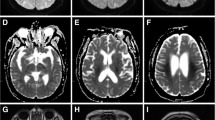Abstract
Hemichorea–hemiballisum in patients with hyperglycemia and striatal hyperintensity on T1-weighted magnetic resonance imaging is now an accepted clinical entity. Usually, both the clinical syndrome and neuroimaging abnormalities are reversible. A transient, reversible metabolic impairment within the basal ganglion has been considered a possible cause of this disorder. However, the pathophysiology remains to be unclear. We report a 56-year-old man with a prolonged, uncontrolled hyperglycemia (HbA1C: 13.8%) and striatal hyperintensity on T1-weighted MR imaging presenting as reversible focal neurological deficit and irreversible neuroimaging abnormalities on the fourth month when blood sugar was under control (HbA1C 6.0 mg/dl). We hypothesize that neuroimaging abnormalities in our case may be a sequence of an “ischemic insult” caused by prolonged, uncontrolled hyperglycemia. Whether the signal abnormalities on neuroimaging studies or the clinical syndrome are reversible (patients with HCHB) or irreversible (such as in our case) are based on the degree of ischemic damage.

Similar content being viewed by others
References
Lee BC, Hwang SH, Chang GY (1999) Hemiballismus-hemichorea in older diabetic women: a clinical syndrome with MRI correlation. Neurology 52:646–648
Lai PH, Tien RD, Chang MH et al (1996) Chorea-ballismus with nonketotic hyperglycemia in primary diabetes mellitus. AJNR Am J Neuroradiol 17:1057–1064
Shan DE, Ho DM, Chang C et al (1998) Hemichorea-hemiballism: an explanation for MR signal changes. AJNR Am J Neuroradiol 19:863–870
Lin JJ, Lin GY, Shih C et al (2001) Presentation of striatal hyperintensity on T1-weighted MRI in patients with hemiballism-hemichorea caused by non-ketotic hyperglycemia: report of seven new cases and a review of literature. J Neurol 248:750–755
Pisani A, Diomedi M, Rum A et al (2005) Acanthocytosis as a predisposing factor for non-ketotic hyperglycaemia induced chorea-ballism. J Neurol Neurosurg Psychiatry 76(12):1717–1719
Wintermark M, Fischbein NJ, Mukherjee P et al (2004) Unilateral putaminal CT, MR, and diffusion abnormalities secondary to nonketotic hyperglycemia in the setting of acute neurologic symptoms mimicking stroke. AJNR Am J Neuroradiol 25:975–976
Ohara S, Nakagawa S, Tabata K et al (2001) Hemiballism with hyperglycemia and striatal T1-MRI hyperintensity: an autopsy report. Mov Disord 16:521–525
Lai PH, Chen PC, Chang MH et al (2001) In vivo proton MR spectroscopy of chorea-ballismus in diabetes mellitus. Neuroradiology 43:525–531
Chu K, Kang DW, Kim DE et al (2002) Diffusion-weighted and gradient echo magnetic resonance findings of hemichorea-hemiballismus associated with diabetic hyperglycemia: a hyperviscosity syndrome. Arch Neurol 59:448–452
Centonze D, Marfia GA, Pisani A et al (2001) Ionic mechanisms underlying differential vulnerability to ischemia in striatal neurons. Prog Neurobiol 63(6):687–696
Duckrow RB, Beard DC, Brennan RW (1985) Regional cerebral blood flow decreases during hyperglycemia. Ann Neurol 17:267–272
Fujioka M, Taoka T, Hiramatsu KI et al (1999) Delayed ischemic hyperintensity on T1-weighted MRI in the caudoputamen and cerebral cortex of humans after spectacular shrinking deficit. Stroke 30:1038–1042
DeGirolami U, Crowell RM, Marcoux FW (1984) Selective necrosis and total necrosis in focal cerebral ischemia: neuropathologic observations on experimental middle cerebral artery occlusion in the macaque monkey. J Neuropathol Exp Neurol 43:57–71
Garcia JH, Lassen NA, Weiller C et al (1996) Ischemic stroke and incomplete infarction. Stroke 27:761–765
Garcia JH, Liu KF, Ye ZR et al (1997) Incomplete infarct and delayed neuronal death after transient middle cerebral artery occlusion in rats. Stroke 28:2303–2309
Sorimachi T, Fujii Y, Tsuchiya N et al (2004) Striatal hyperintensity on T1-weighted magnetic resonance images and high-density signal on CT scans obtained in patients with hyperglycemia and no involuntary movement: report of two cases. J Neurosurg 101:343–346
Author information
Authors and Affiliations
Corresponding author
Rights and permissions
About this article
Cite this article
Tung, CS., Guo, YC., Lai, CL. et al. Irreversible striatal neuroimaging abnormalities secondary to prolonged, uncontrolled diabetes mellitus in the setting of progressive focal neurological symptoms. Neurol Sci 31, 57–60 (2010). https://doi.org/10.1007/s10072-009-0127-6
Received:
Accepted:
Published:
Issue Date:
DOI: https://doi.org/10.1007/s10072-009-0127-6




